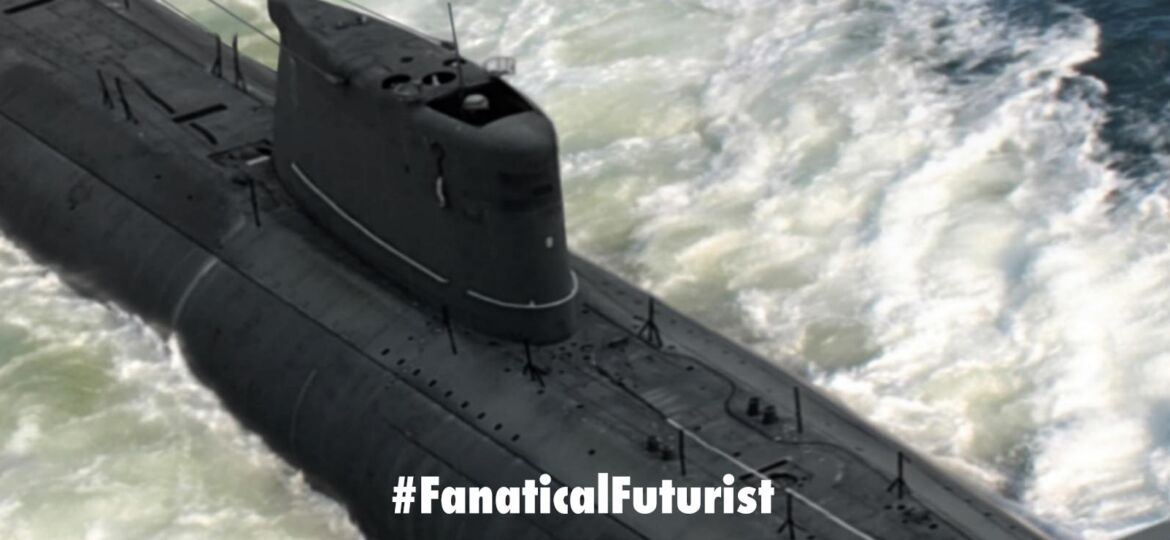
WHY THIS MATTERS IN BRIEF
Innovation can happen anywhere, and if you can find a way to eliminate the friction around torpedoes then they can literally fly at high speed.
 Interested in the Exponential Future? Connect, download a free E-Book, watch a keynote, or browse my blog.
Interested in the Exponential Future? Connect, download a free E-Book, watch a keynote, or browse my blog.
Recently Russia became the first military power in the world to field a hypersonic weapons, and a little while ago I discussed how some of the world’s military powers, including China and the US, were trying to tap into a phenomenon known as supercavitation to create the world’s first supersonic submarines. So now imagine the sudden revelation of a weapon that can suddenly go six times faster than its predecessors. The shock of such a breakthrough system would turn an entire field of warfare on its head, as potential adversaries scrambled to deploy countermeasures to a new weapon they are defenseless against. While a lull in the cold war delayed the development of this new technology now a new so called “Supercavitating torpedo” from Russia may be about to take the military world by storm.
One of the biggest problems with trying to get torpedos to travel faster is the fact that water is a thousand more times dense than air, so in order to overcome that resistance researchers have had to try a variety of different techniques, and in the Russian’s case it’s been to vaporise the liquid water into a gas. Do this and all of a sudden you have a torpedo that, essentially, is “flying” through air.
Shkval performs this stunt by diverting hot rocket exhaust out of its nose, which turns the water in front of it into steam. As the torpedo moves forward, it continues vaporizing the water in front of it, creating a thin bubble of gas. Traveling through gas the torpedo encounters much less drag, allowing it to move at speeds of up 200 knots. This process is known as supercavitation.
The trick with maintaining supercavitation is keeping the torpedo enclosed in the gas bubble. This makes turning maneuvers tricky, as a change of heading will force a portion of the torpedo outside the bubble, causing sudden drag at 230 miles an hour which will literally tear the torpedo, aswell as supersonic submarines, apart. Early versions of Shkval apparently had a very primitive guidance system, and attacks would have been fairly straight torpedo runs.
Considering the warhead would have been nuclear, that would probably have been good enough to destroy the target. It’s clear the Soviet Union believe there were times when torpedo speed was more important than manoeuvrability.
Shkval was originally designed in the 1960s as a means of quickly attacking NATO nuclear missile submarines, delivering a nuclear warhead at previously unheard-of speeds. The torpedo is of standard 533-millimeter torpedo diameter and carries a 460 pound warhead. It has a maximum range of 7,500 yards. Shkval began mass production in 1978 and entered service with the Soviet Navy that year.
Like any weapon, there are drawbacks. For one, the gas bubble and the rocket engine are very noisy. Any submarine that launches a supercavitating torpedo will instantly give away its approximate position. That having been said, such a fast-moving weapon could conceivably destroy the enemy before it has time to act on the information, as the enemy suddenly has a both an enemy submarine and a 200 knot torpedo to contend with.
Another drawback to a supercavitating torpedo is the inability to use traditional guidance systems. The gas bubble and rocket engine produce enough noise to deafen the torpedo’s built-in active and passive sonar guidance systems. Early versions of the Shkval were apparently unguided, trading guidance for speed. A newer version of the torpedo employs a compromise method, using supercavitation to sprint to the target area, then slowing down to search for its target.
Is there a future for the supercavitating torpedo? Well, the US has been working on such a weapon since 1997, apparently without a deployable weapon. Indeed, the US Navy is currently in the process of upgrading the venerable Mark 48 submarine torpedo for service into the foreseeable future. Then again, the Navy’s requirements were far greater than Shkval’s capabilities, including turning, identifying, and homing in on targets.
In the meantime, Russian submarines are the only subs in the world equipped with supercavitating torpedoes, modernized versions of Shval armed with a conventional warhead. Russian industry also offers an export version, Shkval E, for sales abroad. Iran claims to have a supercavitating torpedo of its own it calls Hoot, and which is assumed to be a reverse-engineered Shkval.
In 2004, German defense contractor Diehl-BGT announced the Barracuda, a technology demonstrator torpedo meant to travel up to 194 knots. Barracuda was meant to be launched from submarines and surface vessels, and test models could travel straight and curved paths. However, the program apparently never translated into a marketable weapon.
A noisy but effective weapon Shkval smashes the paradigm of undersea warfare. A 200 knot torpedo is a very attractive capability, and as naval competition heats up in both the Atlantic and Pacific Oceans, we may see even more navies adopting supercavitating designs and adjusting their undersea tactics accordingly. Undersea warfare is about to get a whole lot louder – and deadlier.
















